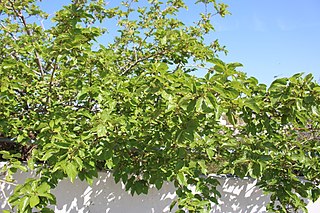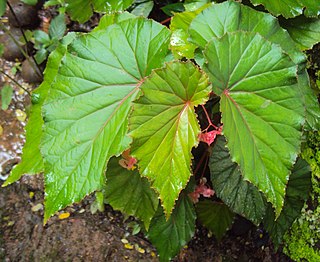
Artemisia is a large, diverse genus of plants with between 200 and 400 species belonging to the daisy family Asteraceae. Common names for various species in the genus include mugwort, wormwood, and sagebrush.

Morus alba, known as white mulberry, common mulberry and silkworm mulberry, is a fast-growing, small to medium-sized mulberry tree which grows to 10–20 m (33–66 ft) tall. It is generally a short-lived tree with a lifespan comparable to that of humans, although there are some specimens known to be more than 250 years old. The species is native to China and India and is widely cultivated and naturalized elsewhere.

Artemisia absinthium is a species of Artemisia, native to North Africa and temperate regions of Eurasia, and widely naturalized in Canada and the northern United States. It is grown as an ornamental plant and is used as an ingredient in the spirit absinthe and some other alcoholic beverages.

Sida cordifolia is a perennial subshrub of the mallow family Malvaceae native to India. It has naturalized throughout the world, and is considered an invasive weed in Africa, Australia, the southern United States, Hawaiian Islands, New Guinea, and French Polynesia. The specific name, cordifolia, refers to the heart-shaped leaf.

Artemisia scoparia is a Eurasian species in the genus Artemisia, in the sunflower family. It is widespread across much of Eurasia from France to Japan, including China, India, Russia, Germany, Poland, central + southwest Asia, etc.

Triterpenes are a class of chemical compounds composed of three terpene units with the molecular formula C30H48; they may also be thought of as consisting of six isoprene units. Animals, plants and fungi all produce triterpenes, including squalene, the precursor to all steroids.

Galangin is a flavonol, a type of flavonoid.

Hyperoside is a chemical compound. It is the 3-O-galactoside of quercetin.

Prenylated flavonoids or prenylflavonoids are a sub-class of flavonoids. They are widely distributed throughout the plant kingdom. Some are known to have phytoestrogenic or antioxidant properties. They are given in the list of adaptogens in herbalism. Chemically they have a prenyl group attached to their flavonoid backbone. It is usually assumed that the addition of hydrophobic prenyl groups facilitate attachment to cell membranes. Prenylation may increase the potential activity of its original flavonoid.

Equisetum myriochaetum, also known as Mexican giant horsetail, is a species of horsetail that is native to Nicaragua, Costa Rica, Colombia, Venezuela, Ecuador, Peru and Mexico. It is the largest horsetail species, commonly reaching 15 feet (4.6 m), with the largest recorded specimen having a height of 24 feet (7.3 m). It is semi-aquatic and is often found growing on riverbanks.

Rhus chinensis, the Chinese sumac or nutgall tree, is a deciduous shrub or small tree in the genus Rhus. Growing to 6 m (20 ft) tall, it has downy shoots and leaves comprising several leaflets. These turn red in autumn before falling.

Verbascoside is a caffeoyl phenylethanoid glycoside in which the phenylpropanoid caffeic acid and the phenylethanoid hydroxytyrosol form an ester and an ether bond respectively, to the rhamnose part of a disaccharide, namely β-(3′,4′-dihydroxyphenyl)ethyl-O-α-L-rhamnopyranosyl(1→3)-β-D-(4-O-caffeoyl)-glucopyranoside.

Pterocarpans are derivatives of isoflavonoids found in the family Fabaceae. It is a group of compounds which can be described as benzo-pyrano-furano-benzenes which can be formed by coupling of the B ring to the 4-one position.

Bakuchiol is a meroterpene in the class terpenophenol.
Dorstenia mannii is a plant species in the genus Dorstenia.

Rosiridin is a chemical compound that has been isolated from Rhodiola sachalinensis. Rosiridin can inhibit monoamine oxidases A and B, possibly meaning that the compound could help in the treatment of depression and senile dementia.

Dendrobium plicatile is an Asian orchid species, a member of the genus Dendobium. It was formerly described as Flickingeria fimbriata.

Sarcococca saligna, the sweet box or Christmas box, is a species of flowering plant in the family Buxaceae. This shrub is native to northern Pakistan. Its common name in Pakistan is sheha.

Vobasine is a naturally occurring monoterpene indole alkaloid found in several species in the genus Tabernaemontana including Tabernaemontana divaricata.

Begonia malabarica, the Malabar begonia, is a species of flowering plant in the family Begoniaceae, native to India and Sri Lanka. It has antibacterial properties.




















